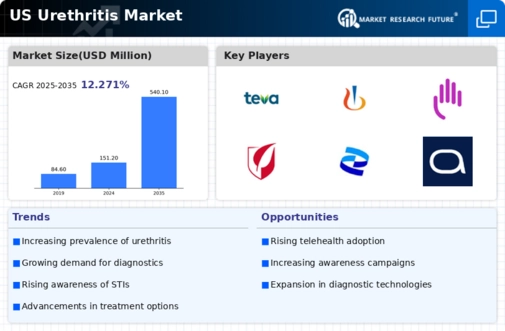Growing Healthcare Expenditure
The increasing healthcare expenditure in the US is a significant driver for the urethritis market. As healthcare spending rises, more resources are allocated to the diagnosis and treatment of various medical conditions, including urethritis. This trend is supported by the expansion of insurance coverage and the emphasis on comprehensive healthcare services. According to recent reports, healthcare expenditure in the US is projected to reach $4 trillion by 2025, which may facilitate greater access to urethritis treatments. Consequently, this financial commitment is likely to enhance the growth prospects of the urethritis market, as more patients seek timely and effective care.
Enhanced Public Health Initiatives
Enhanced public health initiatives aimed at reducing the incidence of STIs are influencing the urethritis market. Government and non-government organizations are increasingly focusing on awareness campaigns, education, and preventive measures to combat STIs, including urethritis. These initiatives are likely to lead to earlier detection and treatment of urethritis cases, thereby increasing the demand for related healthcare services. As public health strategies evolve, they may contribute to a projected market growth of 6% over the next few years, underscoring the importance of proactive health measures in the urethritis market.
Increasing Incidence of Urethritis
The rising incidence of urethritis in the US is a critical driver for the urethritis market. Recent data indicates that the prevalence of urethritis has increased, particularly among sexually active individuals. This trend is likely influenced by factors such as changing sexual behaviors and the growing rates of sexually transmitted infections (STIs). As more individuals seek medical attention for urethritis symptoms, the demand for diagnostic and therapeutic solutions is expected to rise. This increase in cases may lead to a projected market growth of approximately 5% annually over the next few years, highlighting the urgent need for effective treatment options in the urethritis market.
Technological Innovations in Treatment
Technological advancements in treatment modalities are significantly impacting the urethritis market. Innovations such as targeted therapies and improved drug formulations are enhancing treatment efficacy and patient compliance. For instance, the introduction of new antibiotics and alternative therapies has shown promise in managing urethritis effectively. Furthermore, the integration of telemedicine in treatment protocols allows for better patient access and follow-up care. As these technologies continue to evolve, they are likely to drive market growth, with estimates suggesting a potential increase in market value by 10% over the next five years, reflecting the dynamic nature of the urethritis market.
Rising Demand for Point-of-Care Testing
The demand for point-of-care testing (POCT) is emerging as a vital driver in the urethritis market. POCT offers rapid and accurate diagnostic results, enabling healthcare providers to make informed decisions quickly. This is particularly important in the context of urethritis, where timely diagnosis can significantly impact treatment outcomes. The convenience and efficiency of POCT are appealing to both patients and healthcare systems, potentially leading to increased adoption rates. As the market for POCT continues to expand, it is anticipated that the urethritis market will experience a growth rate of around 7% annually, reflecting the shift towards more accessible healthcare solutions.




















Leave a Comment